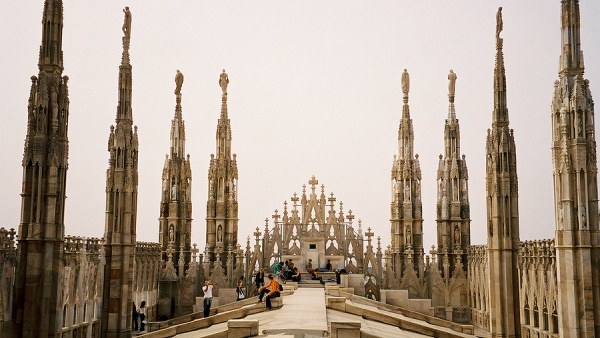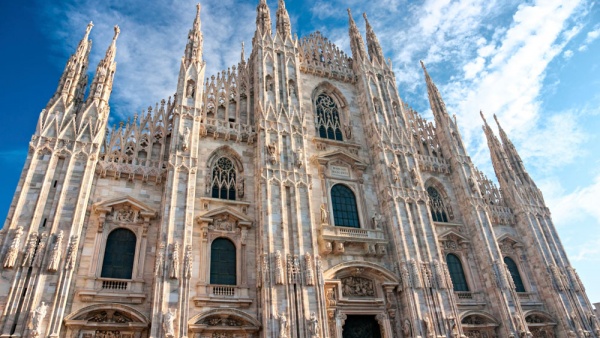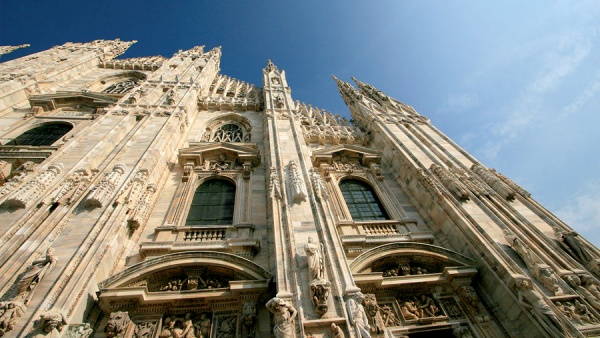Milan Cathedral (Italian: Duomo di Milano [ˈdwɔːmo di miˈlaːno]; Lombard: Domm de Milan) is the cathedral church of Milan, Italy. Dedicated to St Mary of the Nativity (Santa Maria Nascente), it is the seat of the Archbishop of Milan, currently Cardinal Angelo Scola. The Gothic cathedral took nearly six centuries to complete. It is the 5th-largest church in the world and the second largest in Italy.
Milan's layout, with streets either radiating from the Duomo or circling it, reveals that the Duomo occupies what was the most central site in Roman Mediolanum, that of the public basilica facing the forum. The first cathedral, the "new basilica" (basilica nova) dedicated to St Thecla, was completed by 355. It seems to share, on a slightly smaller scale, the plan of the contemporaneous church recently rediscovered beneath Tower Hill in London. An adjoining basilica was erected in 836. The old baptistery, the Battistero Paleocristiano, dates to 335 and still can be visited under the Milan Cathedral. When a fire damaged the cathedral and basilica in 1075, they were rebuilt as the Duomo
In 1386, Archbishop Antonio da Saluzzo began construction of the cathedral. Start of the construction coincided with the ascension to power in Milan of the archbishop's cousin Gian Galeazzo Visconti, and was meant as a reward to the noble and working classes, who had suffered under his tyrannical Visconti predecessor Barnabò. Before actual work began, three main buildings were demolished: the palace of the Archbishop, the Ordinari Palace and the Baptistry of St. Stephen at the Spring, while the old church of Sta. Maria Maggiore was exploited as a stone quarry. Enthusiasm for the immense new building soon spread among the population, and the shrewd Gian Galeazzo, together with his cousin the archbishop, collected large donations for the work-in-progress. The construction program was strictly regulated under the "Fabbrica del Duomo", which had 300 employees led by first chief engineer Simone da Orsenigo. Orsenigo initially planned to build the cathedral from brick in Lombard Gothic style.
Visconti had ambitions to follow the newest trends in European architecture. In 1389, a French chief engineer, Nicolas de Bonaventure, was appointed, adding to the church its Rayonnant Gothic, a French style not typical for Italy. He decided that the brick structure should be panelled with marble. Galeazzo gave the Fabbrica del Duomo exclusive use of the marble from the Candoglia quarry and exempted it from taxes. Ten years later another French architect, Jean Mignot, was called from Paris to judge and improve upon the work done, as the masons needed new technical aid to lift stones to an unprecedented height.[5] Mignot declared all the work done up till then as in pericolo di ruina ("peril of ruin"), as it had been done sine scienzia ("without science"). In the following years Mignot's forecasts proved untrue, but they spurred Galeazzo's engineers to improve their instruments and techniques. Work proceeded quickly, and at the death of Gian Galeazzo in 1402, almost half the cathedral was complete. Construction, however, stalled almost totally until 1480, for lack of money and ideas: the most notable works of this period were the tombs of Marco Carelli and Pope Martin V (1424) and the windows of the apse (1470s), of which those extant portray St. John the Evangelist, by Cristoforo de' Mottis, and Saint Eligius and San John of Damascus, both by Niccolò da Varallo. In 1452, under Francesco Sforza, the nave and the aisles were completed up to the sixth bay.
Giovanni Antonio Amadeo on the "Amadeo's Little Spire".
In 1500 to 1510, under Ludovico Sforza, the octagonal cupola was completed, and decorated in the interior with four series of 15 statues each, portraying saints, prophets, sibyls and other characters of the Bible. The exterior long remained without any decoration, except for the Guglietto dell'Amadeo ("Amadeo's Little Spire"), constructed 1507-1510. This is a Renaissance masterwork which nevertheless harmonized well with the general Gothic appearance of the church.
During the subsequent Spanish domination, the new church proved usable, even though the interior remained largely unfinished, and some bays of the nave and the transepts were still missing. In 1552 Giacomo Antegnati was commissioned to build a large organ for the north side of the choir, and Giuseppe Meda provided four of the sixteen pales which were to decorate the altar area (the program was completed by Federico Borromeo). In 1562, Marco d' Agrate's St. Bartholomew and the famous Trivulzio candelabrum (12th century) were added.












